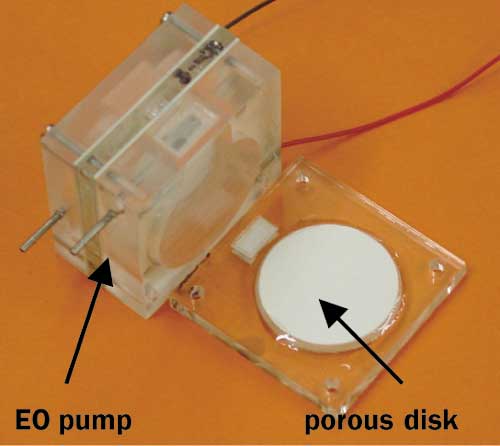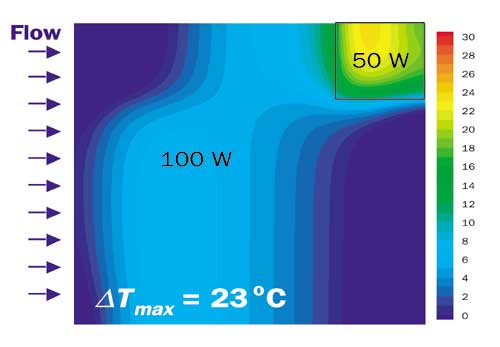Computer heat sinks, such as fin arrays and heat pipes, are much larger than silicon chips and are continuing to grow in size. This trend is driven by the increasing chip heat generation rates and has serious implications for overall system performance. The large volume of existing heat sinks causes discrete memory, video, and power-delivery components to be crowded away from the microprocessor, increasing signal delays among chips and limiting the system speed.
A Stanford research team is using MEMS technology to explore the lower bound volume for the heat sink. The technology combines two-phase convection in micromachined silicon heat sinks (microchannels) with a novel electroosmotic pump to achieve minimal heat sink volume at the chip backside [1, 2]. The hermetically-sealed closed loop, depicted schematically in Figure 1, features a novel and compact electroosmotic pump, forced two-phase convection in the heat sink, and a remote heat rejecter. Figure 2 is a picture of the actual cooling loop implemented in a laptop computer.
 |
Figure 1. Schematic of the electroosmotic microchannel cooling system, which was developed at Stanford University and has been licensed to a startup company (Microflux, Inc. in Mountain View, CA).
 |
Figure 2. The electroosmotic microchannel cooling system implemented in a laptop computer. A 1 cm x 1 cm silicon microchannel heat exchanger is attached to the processor. The rejecter coil and plate are located at the backside of the display panel. An EO pump propels water through the loop, making use of the power supply for the fan with a converter.A recent demonstration on an Intel thermal test chip removed a peak heat flux exceeding 100 W/cm2 and a total heat load exceeding 130 W. The microchannel heat sink was attached to the backside of the thermal chip using a thermal interface material with a thermal conductivity near 1.1 Wm-1K-1. The demonstration was performed with a minimum absolute pressure of 30 kPa and achieved a heat sink temperature of 85oC. The measured maximum junction temperature is about 110oC due to the thermal resistance of the interface material.
Microchannel cooling for circuits has received much attention since its introduction in the early 1980’s by Tuckerman and Pease [3]. However, the lack of a compact, reliable pumping technology with the necessary pressure and flowrate characteristics has limited the commercial application of microchannels. Electroosmotic pumps use an external electric field through a microporous glass frit to move ions within the bulk liquid, and simple ion drag creates a net motion of the bulk liquid.
The pump developed at Stanford [4], (see Figure 3), consists of an ultra-fine porous glass filter disk as the active pumping structure, a catalytic gas recombiner, platinum electrodes, and Plexiglas machined parts. The pumping structure has a diameter of 30 mm, a thickness of 2 mm, and an effective pore diameter of 1 �m. Demonstrations have been performed for Intel and Apple using 1�M buffered de-ionized water (1 �M Na2B4O7 10 H2O dissolved into 1 liter de-ionized water) as the working fluid. The pumps provide the necessary flowrates (> 20 ml/min with 60 V/mm fields) and pressure drop (>2 bar with 100 V potential) using minimal volume and no moving parts.
 |
Figure 3. An image of the electroosmotic pump and its active pumping structure.The Stanford team has developed microchannel heat sinks and supporting simulation tools that tackle the growing problem of microprocessor hotspots. The channels feature varying cross-sectional area, lateral cross-linkages, locally-enhanced surface roughness, and even non-planar vertical connections (3D microchannels) to stabilize two-phase flow and help achieve better temperature uniformity on the chip. Recent simulations performed collaboratively with Intel [5] have shown that the careful design of microchannel configurations can alleviate on-chip hotspots much more effectively than copper heat spreaders (see Figure 4).
 |
Figure 4. Simulated temperature distribution in a 20 mm x 20 mm chip heated non-uniformly and dissipated using a microchannel heat sink. A power of 50 W is concentrated at a 5 mm x 5 mm hotspot while 100 W is applied to the remainder of the chip. A thermal interface material with a thermal resistance of 0.1 cm2K/W is used between the heat sink and the thermal chip in the simulation. The liquid flowrate is 20 ml/min at the inlet with an exit pressure of 0.3 bar.In conclusion, electroosmotic microchannel cooling is promising for the cooling of future electronic systems. Demonstrations have been performed for Intel (single processor) and Apple (dual processor) systems with a total power removal exceeding 130 W. The technology offers very large peak heat removal capability while minimizing the occupation at the chip backside, and can remove extreme rates of heat generation using higher flowrates with optimal microchannel designs. The electroosmotic pump has no moving mechanical parts and generates little noise. The silicon microchannel heat exchanger can alleviate microprocessor hotspots to achieve better chip temperature uniformity.
Future work should focus on demonstrating and improving the system reliability. The stability and reliability of the recombination system for the gas generated within the pump due to electrolysis needs to be explored under extreme conditions including high temperature. Other working fluids including water mixtures should be explored to tailor the boiling point. Finally, techniques for minimizing the impact of freezing on the reliability and start-up performance of the cooling system need to be further explored and demonstrated.
References
- Jiang, L., Mikkelsen, J., Koo, J., Hube,r D., Yao, S., Zhang, L., Zhou, P., Maveety, J.G., Prashe,r R., Santiago, J.G., Kenny, T.W., Goodson, K.E., “Closed-Loop Electroosmotic Microchannel Cooling System for VLSI Circuits”, IEEE Transactions on Components & Packaging Technologies, in press, 2002.
- Jiang, L., Mikklsen, J., Koo J., Zhang, L., Huber, D., Yao, S., Bari, A., Zhou, P., Santiago, J., Kenny, T., Goodson, K.E., “Transient and Sub-Atmospheric Performance of a Closed-Loop Electroosmotic Microchannel Cooling System”, Proceeding of Thermal Challenges in Next Generation Electronic Systems, THERMES 2002, Santa Fe, New Mexico, USA, Jan. 13-16, 2002, pp. 133-139.
- Tuckerman, D.B., Pease, R.F.W., “High-Performance Heat Sinking for VLSI”, IEEE Electron Device Letters, Vol. EDL2, No. 5, 1981, pp.126-129.
- Yao, S., Huber, D.D., Mikkelsen, J., Santiago, J.G., “A Large Flowrate Electroosmotic Pump with Micron Pores”, The International Mechanical Engineering Congress and Exposition, Sixth Micro-Fluidic Symposium, IMECE2001/MEMS-23890, New York, New York, 2001.
- Koo, J., Jiang, L., Bari, A., Zhang, L., Wang, E., Kenny, T.W., Santiago, J.G., Goodson, K.E., “Convective Boiling in Microchannel Heat Sinks with Spatially-Varying Heat Flux”, ITHERM 2002, San Diego, CA, USA, May, 2002, pp.341-346.






